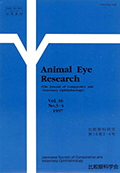Volume 16, Issue 3-4
Displaying 1-9 of 9 articles from this issue
- |<
- <
- 1
- >
- >|
Original Reports
-
1997Volume 16Issue 3-4 Pages 3-4_73-3-4_85
Published: 1997
Released on J-STAGE: December 25, 2020
Download PDF (6737K) -
1997Volume 16Issue 3-4 Pages 3-4_87-3-4_93
Published: 1997
Released on J-STAGE: December 25, 2020
Download PDF (3953K) -
1997Volume 16Issue 3-4 Pages 3-4_95-3-4_98
Published: 1997
Released on J-STAGE: December 25, 2020
Download PDF (1625K) -
1997Volume 16Issue 3-4 Pages 3-4_99-3-4_105
Published: 1997
Released on J-STAGE: December 25, 2020
Download PDF (2632K)
Short Reports
-
1997Volume 16Issue 3-4 Pages 3-4_107-3-4_110
Published: 1997
Released on J-STAGE: December 25, 2020
Download PDF (1755K)
Case Reports
-
1997Volume 16Issue 3-4 Pages 3-4_111-3-4_114
Published: 1997
Released on J-STAGE: December 25, 2020
Download PDF (1718K) -
1997Volume 16Issue 3-4 Pages 3-4_115-3-4_116
Published: 1997
Released on J-STAGE: December 25, 2020
Download PDF (868K)
Information & Data
-
1997Volume 16Issue 3-4 Pages 3-4_117
Published: 1997
Released on J-STAGE: December 25, 2020
Download PDF (415K) -
1997Volume 16Issue 3-4 Pages 3-4_118-3-4_120
Published: 1997
Released on J-STAGE: December 25, 2020
Download PDF (1167K)
- |<
- <
- 1
- >
- >|
